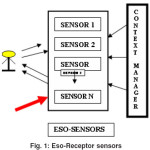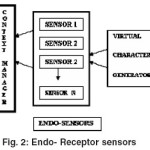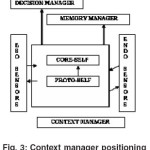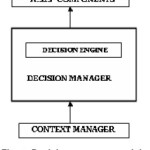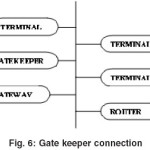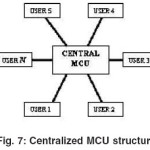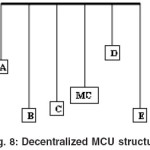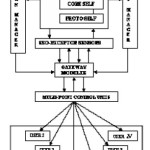Multi-User Communication Through Ambient Intelligence Devices Using H. 323 Protocol
B. Vijaya Babu¹, M. Surendra Prasad Babu² and P. Sunitha³
¹Department of IST, KLCE, Guntur (India)
²Department of CS and SE, College of Engineering, Andhra University, Visakhapatnam (India)
³Department of CSE, PVPSIT, Krishna (India)
Article Publishing History
Article Received on :
Article Accepted on :
Article Published :
Article Metrics
ABSTRACT:
Ambient Intelligence devices are developed from Ubiquitous computing and communications and Intelligent User –friendly Interfaces. Ambient Intelligence refers to electronic environments that are sensitive and responsive to the presence of people. These devices provide vocal interaction with users but serve only a single-user Environment. H. 323 is a standard that specify many components, protocols and procedures that serve establishing multi-user communication. In our research, we embedded supportive H. 323 components to those of ambient device architecture and proposed a new architecture that supports multi-user communication environment through Ambient Intelligent devices. We threw light on advantages of using H.323 over other protocols.
KEYWORDS:
Ambient Intelligence (AmI); Eso-Endo sensors; H.323; Multi-point Control Units (MCUs)
Copy the following to cite this article:
Babu B. V, Babu M. S. P, Sunitha P. Multi-User Communication Through Ambient Intelligence Devices Using H. 323 Protocol. Orient. J. Comp. Sci. and Technol;1(1)
|
Copy the following to cite this URL:
Babu B. V, Babu M. S. P, Sunitha P. Multi-User Communication Through Ambient Intelligence Devices Using H. 323 Protocol. Orient. J. Comp. Sci. and Technol;1(1). Available from: http://www.computerscijournal.org/?p=2037
|
Introduction
Now-a-days Technology becomes embedded in everyday objects such as furniture, clothes, vehicles, roads and smart materials, and people are provided with the tools and the processes that are necessary in order to achieve relaxing interactions with this environment. Every new technology is manifested with objects that realize it. These objects may be new or improved versions of existing objects, which by using the new technology, allow people to carry out new tasks or old tasks in new and better ways. So, we introduced a new technology called H.323 standard protocol with Ambient Intelligence devices that establishes multi-user communications in Ambient Intelligence devices.
Different components related to H.323 standard and Ambient Intelligence devices are presented briefly in our next section.
Ubiquitous computing
Ubiquitous Computing can be defined as the use of computers and hence computing environment everywhere. Computers are made available to the users in real-time environment, in an invisible way. The Ubiquitous intelligent user interfaces, as their name indicates, enable the interaction of inhabitants with AmI environments ina personalized and natural way. They contain sensors and interfaces that support Human Computer Interaction.
Smart spaces
Smart Spaces play an important role in Ambient Intelligent Devices. The virtual characters generated by sensors are stored in smart spaces.
Smart spaces have the ambitious goal of augmenting user capabilities by supporting them in their tasks, which involve interaction not only across
the boundaries of smart devices, but also across different physical locations. A common requirement for many AmI systems is that of supporting their
users with guidance on available services, safety warnings and navigation aids, which are provided by Smart space technology. With embedding H.323 standard related components in the architecture, we can make it a multiple user environment.
Virtual characters
Virtual Character based interfaces, allow the system to address the user by means of a range of natural communication modalities: voice, eye gaze, facial expressions and gestures. Additionally, a high degree of flexibility can be achieved if a virtual character can adapt not only message content but
also the related emotional information by means of non-verbal modalities. Fundamental functions of a smart space are perception, analysis, decision, and action.
Context awareness
Context-awareness refers to the property of a Smart Space to internally represent events, the state of its users, of their surroundings and of Smart Space parts. Therefore, in a context aware Smart Space, contextual information can be either used by itself, i.e., it can have its own value for the interacting user, or it can be used to select which services can be provided to the user and which interaction modalities are more suited to let him/ her access such services.
Multimodal communication
Multi-modal communication can be defined as a simultaneous exchange of information over multiple channels at different levels of
abstraction. In a smart space, where users must be able to access services not only when they are sitting in front of a PC screen, but as they move freely within the environment and at the same time attend to other tasks. To make the interface as transparent as possible, only way is to address the
user. Our starting point is that human-to-human communication is an extremely rich and varied exchange of information, which exploits a multitude
of channels and modalities. A channel is an effective and sensory means that perform transmission and reception operation. A modality can be defined as a specific way to use a channel.
Internal components
Following are the major components present in Ambient devices.
- Eso-Receptor Sensors.
- Endo-Receptor Sensors.
- Context Manager.
- Decision Manager.
- Memory Manager.
Initially, a sensor is a type of transducer which uses a signal of some sort, and converts it into a reading for the purpose of information transfer.
Sensors are applied at a remarkable extent in the field of Ambient Intelligence
Eso-Receptor sensors
Eso-type sensors send or receive data from the users and transfer it to and from context manager module. In the user perspective in the field
of Ambient Intelligence is technically referred as external world. The figure shows a number of sensors receiving or sending the user input and sending data to the context manager.
The thick arrow pointing towards the sensors block is the location where we embed the components supporting H.323 standard.
Endo-type sensors send or receive data from the servers or virtual character generators and transfer it to and from context manager module. In
a single user environment these are related to computer terminology. It is technically referred as Internal World in Ambient Intelligent terms. The figure shows a number of sensors sending or receiving the response output and sending data to the Context Manager. Virtual Character Generator generates automatic words and transfers them to sensors
Context manager
Context Manager works on the basis of context awareness concept. There exist three main internal components. They are explained below.
Proto-self
The Proto-Self is an interconnected and temporarily coherent collection of internal neural patterns which represent the state of the testing user, moment by moment, at multiple levels of the brain. Proto-Self functionality can be realized through the non-conscious human monitoring on the inner parts of the user This functionality is technically called as internal state context analysis.
Core Self
Core Self is generated for any object that provokes the core-consciousness mechanism that is to say the continuous environment awareness
due to the analysis of stimulating objects. The mechanism of Core-Self requires the presence of Proto-Self.
Autobiographical self
The Autobiographical Self is a conscious part of self, based on autobiographical memory which is constituted by implicit memories of multiple instances of individual experience of the past and of the anticipated future.
Decision manager
Decision Manager acts as an interface between internal world and External world. It transmits data to or receives data from the Context manager module and passes it to either computer or users
The Decision Manager module internally contains a decision engine (also called rule engine) that decides to send the information whether to computer or user. Beside this, it is also responsible for exploiting knowledge about the current context to adapt its response to the user, and, together with the Multimodal Communication module, to his/her terminal. The decision engine takes two kinds of input. One type of input can be from the Context
Manager Module, the other can be directly from the users (s) who are in interaction.
Memory manager
The concept of smart spaces comes to focus under memory manager. Memory manager, as the name indicates, manages memory issues, stores the virtual characters generated by creators in it. Whenever, if they are required, it passes the information to either internal world or External world.
Overview of H.323 standard protocols
H.323 (recommended by ITU for multimedia communications over LAN) is a standard that contain number of components, protocols and
procedures that establish Multi-user communication services like real-time audio, video or both. It is a key-stone for LAN based products for consumer,
business and entertainment along with professional applications.
H.323 enable videoconferencing across a range of networks, known as H.32X, this series includes H.320 and H.324, which address ISDN and PSTN communications, respectively. Following are the important components in H.323 standard.
- Terminals
- Gate Keepers
- Gateways
- Multi-point Control Units (MCUs)
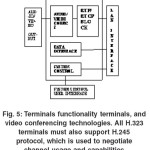 |
Figure 5: Terminals functionality terminals, and video conferencing technologies. All H.323 terminals must also support H.245 protocol, which is used to negotiate channel usage and capabilities
Click here to View figure
|
Terminals
Terminals are the client endpoints on the LAN that provide real-time, two-way communications. All terminals must support voice communications; video and data are optional. H.323 specifies the modes of operation required for different audio, video, and/or data terminals to work together. It is the dominant standard of the next generation of internet phones, audio conferencing.
Gate keepers
In many ways, an H.323 gatekeeper acts as a virtual switch. Gatekeepers perform two important control functions. The first is address
translation from LAN aliases for terminals and gateways to IP or IPX addresses, as defined in the RAS (Registration, Admission and Status
specification. The second function is bandwidth management .Gatekeepers can also play a role in multipoint connections. To support multipoint communication, users would employ a Gatekeeper to receive H.245 Control Channels from two terminals in a point-to-point communication. When
the link is to be switched to multipoint, the Gatekeeper can redirect the H.245 Control Channel to a multipoint controller, the MC.
Gateways
The Gateway is an optional element in an H.323 conference. Gateways provide many services, the most common being a translation function between H.323 conferencing endpoints and other terminal types or other types of communication architectures. This function includes translation between transmission formats and between communications procedures In addition,
the Gateway also translates between audio and video codecs and performs communication setup and clearing on both the LAN side and the switched circuit network side.
Multi-point control units
The Multipoint Control Unit (MCU) supports conferences between three or more endpoints. Under H.323, an MCU consists of a
Multipoint Controller (MC), which is required, and zero or more Multipoint Processors (MP). The two categories of Multi-point conferencing are Centralized Multi-point conference and Decentralized Multi-point conference. Any number of users can simultaneously connect to the MCU and can carry on communication between them or with computer. Centralized multipoint conferences require the existence of an MCU to facilitate a multipoint conference. All send audio, video, data, and control streams to the MCU in a point-to-point fashion. The MC centrally manages the conference
using H.245 control functions that also define the capabilities for each terminal. The MP does the audio mixing, data distribution, and video switching/
mixing functions typically performed in multipoint conferences and sends the resulting streams back.
to the participating terminals. The MP may also provide conversion between different codecs and bit rates and may use multicast to distribute processed video. A typical MCU that supports centralized multipoint conferences consists of an MC and an audio, video, and/or data MP.
Decentralized multipoint conferences can make use of multicast technology. Receiving terminals are responsible for processing the multiple incoming audio and video streams. Terminals use H.245 Control Channels to indicate to an MC how many simultaneous video and audio streams they can decode. In this way communication is established between them.
Our idea-proposed multi-user supportive
architecture
This architecture is designed by embedding components of H.323 standard and those of Ambient Intelligence devices. H.323 applications mainly work on the basis of IP addresses, in order to either setup a communication link or to suspend or delete the link. To establish a multi-user environment, we have designed the architecture based on IP addresses and multi-point control units. Since we focused on communication, after the decision manager Module, we maintain a multi-point control unit. Each and every registered user will be given devices like mobile receivers and other related devices. Every user will be assigned with a unique IP address. Whenever a user wants to communicate with other users or central server, he poses a request to the gate-keeper module. The gateway checks whether the user is a registered one or not. If he is a registered user, then the Gatekeeper assigns a link with the other users or to the other user, whomever he wants, else, if the user is not a registered user, then connection will be discarded automatically. Advantage of assigning IP address is that the central server can contact (communicate) with any number of users either individually or as a group. Whenever users want to communicate with the central server, they can pose request to the server similar to a call setup through Gateways and they can establish communication link. In the architecture we used a centralized multipoint control unit in establishing multi-point
communication.
Advantages of using H.323 standard
- Interoperability
- Flexibility
- Bandwidth Management
- Multicast Support
- Security
Real-time example
If an Intelligence Agency of particular country has to transfer important information to security officials at a faster rate (in any format), they
can apply the above architecture for communication and perform their jobs flexibly.If the information is sent to one destination at a time, there may be
leakage of the confidential information.So if the information is sent to multiple destinations at-once, leakage of the information can be averted.
Conclusion
Future work
The architecture proposed is an experiment done on Ambient Intelligence infrastructure and network communications standard protocol, H.323. In this architecture, the H.323 protocol is embedded to get multi-user communication emulating the device to user communication in Ambient Intelligence architecture. By using the H.323 protocol we have advantages like interoperability, flexibility, bandwidth management, security etc.
There are many other protocols that play quite dominant role in the field of communications. These types of protocols can be taken up a research
projects and many advanced architectures can be designed and explored for enhancing better strategies in communication at cheaper costs.
References
- New Technologies for Ambient Intelligence By Mariano ALCAÑIZ, Beatriz REY.
- A Flexible Architecture for Ambient Intelligence systems. By Stefano PIVA, Carlo Bonamico, Carlo Regazzoni, Fabio lavagetto
- http://www.ambientintelligence.org/
- H.323 versus SIP: A Comparison http://www.packetizer.com/ipmc/h323_vs_sip
- H.323 Protocols Suite http://www.protocols.com/pbook/h323.htm
- H.323 tutorial http://www.iec.org/online/tutorials/h323/
- http://www.h323forum.org/
- http://www.packetizer.com/ipmc/h323/papers/primer/
- H.323 applications: http://www.cisco.com/univercd/cc/td /doc/product/software/ios122/122cgcr/fvvfax_c/vvf323ov.htm#wp1280652
- http://www.itu.int/rec/T-REC-H.323/e
- http://www.openh323.org/standards.html
- Vijaya Babu. B, Prof Surendra Babu,M.Sunitha. P Multi user communication through ambient intelligent devices using H.323 Protocol. In the Proceedings of 2nd national conference on challeneges and opportunities in information technologies,COIT-2008, March 29,Mandi Gobindgarh,Punjab, India.

This work is licensed under a Creative Commons Attribution 4.0 International License.
